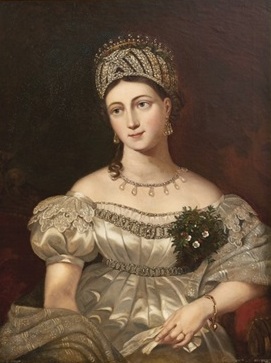Princess Louise of Saxe-Gotha-Altenburg (1800–1831)
German princess From Wikipedia, the free encyclopedia
Louise of Saxe-Gotha-Altenburg (Louise Dorothea Pauline Charlotte Fredericka Auguste); (21 December 1800 – 30 August 1831) was the wife of Ernst I, Duke of Saxe-Coburg and Gotha and the mother of Duke Ernst II and Prince Albert, husband of Queen Victoria.[1]
| Louise of Saxe-Gotha-Altenburg | |||||
|---|---|---|---|---|---|
| Countess of Pölzig and Beiersdorf | |||||
 Posthumous painting by William Corden the Elder, 1844. | |||||
| Duchess consort of Saxe-Coburg-Saalfeld | |||||
| Tenure | 31 July 1817 – 31 March 1826 | ||||
| Born | 21 December 1800 Gotha, Saxe-Gotha-Altenburg, Holy Roman Empire | ||||
| Died | 30 August 1831 (aged 30) Paris, France | ||||
| Burial | Ducal family mausoleum, Friedhof am Glockenberg, Coburg | ||||
| Spouses | |||||
| Issue | |||||
| |||||
| House | Saxe-Gotha-Altenburg | ||||
| Father | Augustus, Duke of Saxe-Gotha-Altenburg | ||||
| Mother | Louise Charlotte of Mecklenburg-Schwerin | ||||
Family
Princess Louise was the only child of Augustus, Duke of Saxe-Gotha-Altenburg and his first wife Louise Charlotte of Mecklenburg-Schwerin, daughter of Frederick Francis I, Grand Duke of Mecklenburg-Schwerin and Princess Louise of Saxe-Gotha-Altenburg (her namesake). She lost her mother only 11 days after her birth and grew up in Gotha at the court of her father and his second wife Karoline Amalie von Hesse-Kassel.[2]
Marriage and issue
Summarize
Perspective

The engagement to the then Duke Ernst I of Saxe-Coburg-Saalfeld took place on December 20 in 1816. On 31 July 1817 in Gotha, 16-year-old Louise married her 33-year-old kinsman Ernst III, Duke of Saxe-Coburg-Saalfeld, (later Ernst I, Duke of Saxe-Coburg and Gotha), after he failed to win the hand of one of the Russian Grand Duchesses.[3] Louise was considered "young, clever, and beautiful".[4]
Their marriage, which was obviously arranged for political reasons, began to fall into crisis after the birth of their first son, Ernst, who inherited his father's lands and titles, and a year later her second son Albert was born, who was later the husband of Queen Victoria.
The couple grew apart. The succession secured, there were no further children and Louise apparently found other solace in men besides her husband. The problem with this was that while Ernest saw no issue with his own infidelity, as was typical for the time, he took great issue with his wife following suit.[citation needed]
Husband Ernst had several mistresses and Louise had an affair with chamberlain Gottfried von Bülow in 1823 and a liaison with traveling stable master Maximilian Alexander von Hanstein in the summer of 1824.[5]
The marriage was unhappy because of Ernst's infidelities and the couple separated in 1824. Sankt Wendel, in the Principality of Lichtenberg, was assigned as her new residence (it was an exclave of Saxe-Coburg und Gotha; see Sotnick on this period), and Louise was forced to leave her two sons behind. Biographer Lytton Strachey noted in 1921: "The ducal court was not noted for the strictness of its morals; the Duke was a man of gallantry, and it was rumored that the Duchess followed her husband's example. There were scandals: one of the Court Chamberlains, a charming and cultivated man of Jewish extraction, was talked of; at last there was a separation, followed by a divorce."[6]
Post-divorce

On 31 March 1826 their marriage was officially dissolved. Seven months later, on 18 October 1826, Louise secretly married in Sankt Wendel her former lover, the Baron Alexander von Hanstein. On 19 July 1826 Alexander was additionally created Count of Pölzig and Beiersdorf by Frederick, Duke of Saxe-Altenburg.
In her previous marriage, she had taken great interest in the social life of the principality and was revered as its Landesmutter (literally, "mother of the region"). Nevertheless, this happy life ended in February 1831, when her secret marriage to Alexander von Hanstein was discovered and she lost her children permanently.
Louise set up house in St Wendel with Count Alexander von Hanstein. Any happiness was short-lived as Louise began to suffer from severe stomach pain. The couple traveled to Paris to consult a reputable doctor, but in August 1831 she collapsed in their home in St Wendel.[1]
Death
Louise died of cancer on 30 August 1831 at the age of 30. Years after her death, Queen Victoria described Louise in an 1864 memorandum: "The princess is described as having been very handsome, though very small; fair, with blue eyes; and Prince Albert is said to have been extremely like her".[7] [8]
Louise was reinterred from her initial burial site at Morizkirche to the ducal mausoleum at Friedhof am Glockenberg after it had been completed in 1859.[9]: 47
Ancestry
| Ancestors of Princess Louise of Saxe-Gotha-Altenburg (1800–1831) |
|---|
References
Sources
External links
Wikiwand - on
Seamless Wikipedia browsing. On steroids.
